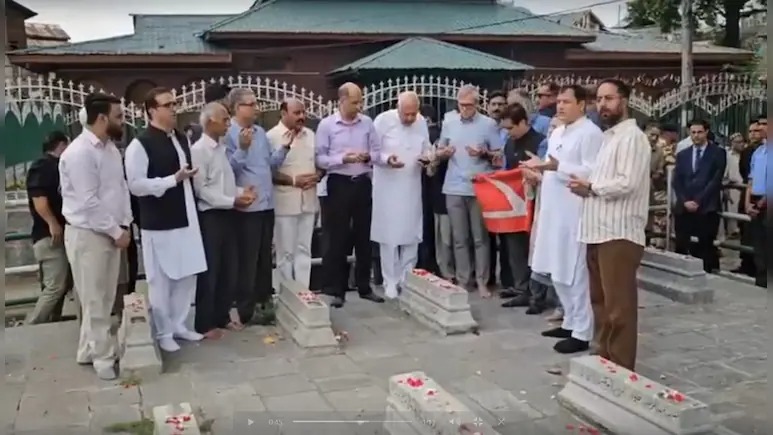Omar Abdullah Scales Wall on Martyrs’ Day in Kashmir: Defiance, Drama, and Democratic Dissent
By: Javid Amin | Srinagar | 14 July 2025
A Wall, A Walk, A Statement: The Moment That Sparked National Headlines
On July 14, 2025, in the heart of Srinagar’s Old City, former Jammu & Kashmir Chief Minister Omar Abdullah did something both unexpected and symbolic: he scaled the locked gates of the Naqshband Sahib graveyard, where the 22 martyrs of July 13, 1931, are buried.
His act came a day after he was reportedly placed under house arrest—a move that, according to him, was meant to prevent elected leaders from paying tribute on what was once a gazetted state holiday known as Martyrs’ Day.
Caught on Camera, Broadcast Across India
Videos of Omar Abdullah walking from Nawhatta Chowk, dodging multiple police barricades, and climbing over the graveyard wall went viral on social media. In his own words:
“They tried to stop us—physically, emotionally, symbolically. But we reached the graveyard. We offered fatiha. They can lock the gates, but not our memories.”
The Lockdown Before the Tribute: What Sparked the Showdown?
July 13: The Day of Official Silence
July 13, the original Martyrs’ Day, saw the Srinagar district administration impose tight restrictions:
-
All roads leading to the Naqshband Sahib graveyard were sealed.
-
Top leaders from National Conference, PDP, Apni Party, and People’s Conference were either confined to their homes or denied entry to the site.
-
No formal government tribute was held, continuing a pattern of erasure since Article 370 was abrogated in 2019.
According to Omar, a police bunker was set up outside his house within minutes of his public request to visit the memorial.
The Wall-Climbing Moment: A Visual of Resistance
The Route, The Barrier, The Climb
On July 14, Omar Abdullah:
-
Walked over a kilometre from Nawhatta Chowk, confronting at least four police barricades.
-
Was stopped by CRPF and J&K Police, who reportedly attempted to block his advance.
-
Found the main gate locked—and scaled the boundary wall to gain entry.
-
Offered fatiha (prayers) at the grave of the 1931 martyrs.
In a tweet later posted on X (formerly Twitter), Omar stated:
“This is not just about Martyrs’ Day—it’s about dignity, memory, and democracy. When elected leaders are treated like threats, what does that say about India’s democracy in Kashmir?”
Political Reactions: Applause, Accusations, and Irony
Supporters: “A Bold Stand Against Authoritarianism”
Many viewed Omar’s gesture as a powerful statement against the continued erosion of democratic space in Jammu & Kashmir.
-
Civil society groups praised the act as civil disobedience in the face of bureaucratic overreach.
-
Former Chief Minister Farooq Abdullah arrived separately in an autorickshaw, drawing comparisons to freedom fighters navigating colonial blockades.
-
Education Minister Sakina Ittoo reached the site riding pillion on a scooty, defying security with symbolism.
Critics: “Theatrics, Not Tribute”
However, reactions weren’t universally sympathetic.
-
Sajad Lone, leader of the People’s Conference, called the event “scripted and unnecessary”, suggesting that Omar was turning solemn remembrance into a political stunt.
-
Iltija Mufti of the PDP, who managed to visit the graveyard a day earlier, accused Omar of grandstanding and failing to protect Martyrs’ Day when in power.
BJP: “Political Drama Based on a Flawed History”
BJP spokesperson Altaf Thakur dismissed the tribute as a “staged event”, doubling down on the party’s stance that July 13, 1931, was not a nationalist movement but a communal riot.
“The real tragedy here is not the locked gate—it’s the continued glorification of violence against Kashmiri Pandits and Dogras in 1931,” said Thakur.
Why It Matters: A Wall That Divides Memory and Power
The Political Symbolism
Omar’s wall-scaling act isn’t just about access to a cemetery—it is about who gets to define remembrance, and what role elected leaders play in a bureaucracy-dominated Union Territory.
This moment crystallizes the post-Article 370 tension in J&K:
-
Martyrs’ Day, once a state-sanctioned commemoration, has been scrubbed from the official calendar.
-
Public memory is being reoriented—with Hari Singh’s birth anniversary added as a holiday instead.
-
Elected leaders continue to operate under administrative restrictions, despite the restoration of the legislative assembly.
“A leader shouldn’t have to climb walls to honor the past. But perhaps in today’s Kashmir, that’s the only way to be seen and heard,” remarked a retired professor from the University of Kashmir.
Martyrs’ Day as a Symbol of Shrinking Democratic Space
The politics surrounding Martyrs’ Day in Kashmir now stand as an annual referendum on democratic freedom, narrative control, and regional identity.
Whether seen as:
-
A heroic gesture of defiance,
-
A choreographed political stunt, or
-
A symbolic protest against silencing elected voices—
Omar Abdullah’s wall-climbing moment has pierced through the noise, drawing national and international attention to how Kashmir’s past is being controlled in the present.
Final Thoughts: The Wall Is Real, But So Is the Message
In most places, politicians cutting ribbons or lighting lamps mark anniversaries of historical significance.
In Kashmir, a former chief minister climbing a wall to pay tribute to martyrs has become the new normal—a stark image of a region where commemoration itself is rebellion, and where memory is both contested and policed.
Omar Abdullah’s act may divide opinion, but it unambiguously signals this:
In Kashmir today, even remembering your history can mean climbing over the fences of silence.



